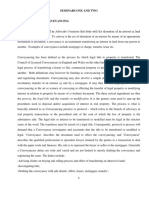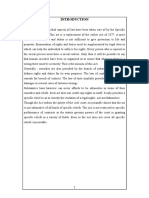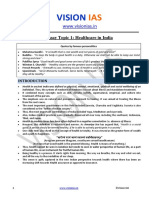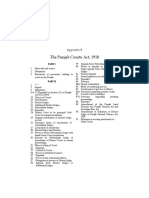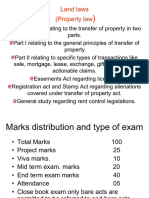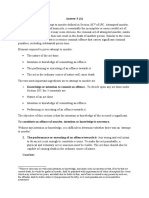Doctrine of Part Performance
Uploaded by
Anshul SinghalCopyright:
Available Formats
Doctrine of Part Performance
Uploaded by
Anshul SinghalOriginal Description:
Original Title
Copyright
Available Formats
Share this document
Did you find this document useful?
Is this content inappropriate?
Copyright:
Available Formats
Doctrine of Part Performance
Uploaded by
Anshul SinghalCopyright:
Available Formats
DOCTRINE OF PART PERFORMANCE
INTRODUCTION
Property is one of the most fundamental elements of the socio-economic life of an individual.
Juridically, property can be said to be a bundle of rights in a thing or a land. However, the word
has gradually been given a wider meaning. Economic significance of the property, therefore,
rests more on its dispositions. Property law has therefore become an important branch of civil
law. The Transfer of Property Act, 1882 deals with the transfer of immoveable property intervivos (although some provisions deal with the transfer of moveable as well as immovable
property).
Before this enactment, the transfers of immovable property were mostly governed by English
equitable principles as applies by Anglo-Indian Courts. The doctrine of part-performance is one
of the equitable doctrines applied by these Courts. In this project, the various aspects of doctrine
of part-performance have been analyzed in detail.
DOCTRINE OF PART PERFORMANCE
Doctrine of part performance is an equitable doctrine. It is also known as equity of partperformance. Under this doctrine, if a person has taken possession of an immovable property on
the basis of contract of sale and has either performed or, is willing to perform his part of contract
then, he would not be ejected from the property on the ground the sale was unregistered and the
legal title had not been transferred to him. For instance, there is a contract for the sale of a piece
of land between A and B. the contract is in writing, stamped, attested and duly executed but not
registered by A, who is the seller. B, who is the purchaser has performed, or is willing to perform
his part of contract i.e. has paid the price or is willing to do the same. On basis of such contract B
takes possession of the land. Now A sells the land to C through a registered deed. C having the
legal title of the land, attempts to eject B. at this stage, since B has no legal title, law may not
protect his possession, but equity shell help him from getting dispossessed. The doctrine of partperformance is, therefore, based on the maxim: Equity looks on that as done which ought to have
been done. That is to say, equity treats the subject-matter of a contract as to its effects in the same
manner as if the Act contemplated in the contract had been fully executed, from the moment the
agreement has been made, though all the legal formalities of the contract have not been
completed.
1 | Page
DOCTRINE OF PART PERFORMANCE
HISTORY OF THE SECTION
Section 53A of the Transfer of Property Act provides that Where any person contracts to
transfer for consideration any immoveable property by writing signed by him or on his behalf
from which the terms necessary to constitute the transfer can be ascertained with reasonable
certainty,
and the transferee has, in part performance of the contract, taken possession of the property or
any part thereof, or the transferee being already in possession, continues in possession in part
performance of the contract and has done some act in furtherance of the contract,
and the transferee has performed or is willing to perform his part of the contract,
then, notwithstanding that [..]1 where there is an instrument of transfer, that the transfer has not
been completed in the manner prescribed therefore by the law for the time being in force, the
transferor or any other person claiming under him shall be debarred from enforcing against the
transferee and persons claiming under him any right in respect of the property of which the
transferee has taken or continued in possession, other than the rights expressly provided by the
terms of the contract:
Provided that nothing in this Section shall affect the rights of a transferee for consideration who
has no notice of the contract or of the part performance thereof.
The Section has been described by the Privy Council2, and by the Supreme Court3, as partial
importation of the English of doctrine of part performance. By virtue of this Section part
1 The words the contract, though required to be registered, has not been registered or has been omitted
by Section 10 of the Registration and Other Related Laws Amendment Act 2001 (Act no. 48 of 2001)
with effect from 24 September, 2001.
2 Mian Pir Bux v. Sardar Mahomed Tahar, AIR 1934 PC 235; AMA Sultan and Ors. v. Seydu Zohra
Beevi, AIR 1990 Ker 186.
3 Maneklal Manuskhbahi v. Honnusji Jamshedji, AIR 1950 SC 1; Chaliagulla Ramchandrayya v.
Boppana Satyanarayana, AIR 1964 SC 877; See also Nathu Lal v. Phoolchand, [1970] 2 SCR 854; Sardar
Govindrao Mahadik & anr. v. Devi Sahai and ors., AIR 1982 SC 989.
2 | Page
DOCTRINE OF PART PERFORMANCE
performance does not give rise to an equity, as in England, but to a statutory right. 4 This right is
more restricted than the English equity in two respects: (1) there must be a written contract; and
(2) it is only available as a defence.5 So far as India is concerned, the section creates rights which
were not in existence before the enactment was passed. 6 These rights to retain possession rest on
the express provisions of the statute. It has been held that the doctrine of part performance is not
applicable to the State of Jammu and Kashmir.7
Section 53A was first enacted in 1929 by the Transfer of Property (Amendment) Act 1929, and
imports into India a modified form of equity of part-performance as developed in England in
Maddison8. The enactment of the section sets at rest the considerable uncertainty prevailing in
Indian law as can be seen by three decisions of the Privy Council.9
Recently, para 4 of Section 53A has been amended by Section 10 of the Registration and Other
Related Laws (Amendment) Act 2001 (Act 48 of 2001) whereby the words the contract, though
required to be registered, or has been omitted.10
SCOPE OF THE SECTION
The following postulates are sine qua non for basing a claim on Section 53 A of the Transfer of
Property Act:
4 Amrao v. Baburao, (1950) ILR Nag 25. See Hamida v. Smt Humer and ors., AIR 1992 All 346.
5 U.N.Sharma v. Puttegowda and anr., AIR 1986 Kant. 99.
6 Kripa Ram v. Bishen Das, AIR 1944 Lah 179.
7 Swaran Kumar Jain v. Dev Dutt Mahajan and ors., AIR 1994 J&K 33.
8 (1883) 8 App Cas 467.
9 Mahomed Musa v. Aghore Kumar Ganguli, (1914) ILR 42 Cal 801; Ariff v. Jadunath, AIR 1931 PC 79;
Mian Pir Bux supra note 2.
10 G.C.BHARUKA, MULLA THE TRANSFER OF PROPERTY ACT 417 (10th ed Lexis Nexis
Butterworths Wadhwa Nagpur 2006).
3 | Page
DOCTRINE OF PART PERFORMANCE
a) There must be a contract to transfer for consideration any immoveable property.
b) The contract must be in writing, signed by the transferor, or by someone on his behalf.
c) The writing must be in such words from which the terms necessary to construe the
transfer can be ascertained.
d) The transferee must in part performance of the contract take possession of the property,
or of any part thereof.
e) The transferee must have done some act in furtherance of the contract.
f) The transferee must have performed or be willing to perform his part of the contract.11
So far as applicability of Section 53A is concerned, what is to be seen is that the Section provides
for a shield of protection to the proposed transferee to remain in possession against the original
owner who has agreed to sell to the transferee to remain in possession against the original owner,
who has agreed to sell to the transferee, if the proposed transferee satisfies the other conditions
of Section 53A.12 Proposed transferor remains full owner of the lands till they are legally
conveyed by a sale deed to the proposed transferees.13 Such a right to protect possession against
the vendor cannot be pressed in service against a third party like a state when it seeks to enforce
the provisions of the Act against the tenure-holder.14
In absence of the pleadings and evidence of all the essential conditions, making out a defence of
part performance to protect possession claimed by the plaintiff, would not be attracted. 15 The plea
under Section 53 A of the TP Act raises a mixed question of law and fact, and therefore, cannot
be permitted to be urged for the first time at the stage of second appeal.16
11 Nathulal supra note 3; Shrimat Shamrao Suryavanshi v. Prahlad Bhairoba Suryavanshi, AIR 2002 SC
960; Rambhao Namdeo Gajre v. Narayan Bapuji Dhotra, (2004) 8 SCC 614; Ram Kumar Agarwal v.
Thawar Das, (1999) 7 SCC 303; Jacobs Private Limited v. Thomas Jacob, AIR 1995 Ker 249. See also
Damodaran v. Shekharan, AIR 1993 Ker 242, M. Mariappa v. A.K. Sathyanarayan Shetty, AIR 1984 Kant
58.
12 supra note 10.
13 Id.
14 State of Uttar Pradesh v. District Judge, AIR 1997 SC 53.
15 Hazilal v. Jugal Kishore, AIR 1999 MP 104.
4 | Page
DOCTRINE OF PART PERFORMANCE
IS THE SECTION RETROSPECTIVE?
There is a sharp cleavage of judicial opinion on this question. The Madras High Court has
consistently held that the Section has no retrospective operation and does not apply to transfers
effected prior to 1st April, 1930.17 The Calcutta High Court has said that the section applies
retrospectively, except that the Section would not apply to such transactions which were the
subject matter of pending actions on 1st April, 1930.18 This is the present view also of Patna High
Court though there are earlier decisions of the Court to the contrary. The Allahabad High Court
also holds that Section 53A applies to transactions that took place prior 1 st April, 1930 provided
the suit is brought after that date.19 The Bombay High Court agrees with this view. The present
view of all the High Courts is that Section 53A does not affect any proceeding commenced
before the Amending Act of 1929.20
ESSENTIAL CONDITIONS FOR THE APPLICATION OF THIS SECTION
Analysis of the provisions of Section 53A makes it clear that following essential conditions are
necessary for its application:
a) There is a contract for the transfer of an immovable property. The contract must be
written and it must be for the transfer of an immovable property for consideration. 21 Also,
the contract must be valid in all respects.
16 Ram Kumar Agarwal supra note 11; Sham Lal v. Mathi, AIR 2002 HP 66 .
17 Kanakamma v. Krishnamma, (1943) 1 MLJ 335(F.B.), Mahalakshmi v. Venkatareddi, AIR 1944 Mad
556.
18 Madan Mohan v. Srinivas Prasad, AIR 1943 Pat 343.
19 Gajdhar v. Bachan, AIR 1943 All 768.
20 VERA P. SARTHI, G.C.V. SUBBA RAOS LAW OF TRANSFER OF PROPERTY (EASEMENTS,
TRUST AND WILLS) 691 (Reprint ed Alt Publications Hyderabad 2005).
21 Hamida supra note 4.
5 | Page
DOCTRINE OF PART PERFORMANCE
b) The second essential is that the transferee has taken the possession of the property or
continues possession in part-performance of the contract or, has done some act in the
furtherance of the contract.22
c) When a person claims protection of his possession over a land under Section 53A, his
own conduct must be equitable and just. That is the transferee has either performed his
part of contract or is willing to perform the same.
When the above mentioned conditions are fulfilled, the transferee can defend his continuance of
possession over the property. In other words, if these requirements are fulfilled, the transferee is
entitled to claim, under this Section, that he should not be dispossessed or evicted from the
property.
ACT OF PART PERFORMANCE
Repairs and improvements affected under a mortgage cannot be an act of part performance under
a subsequent sale, as it is an act preliminary to a sale. 23 The mere retention by a tenant 24, or a
mortgagee in possession25, of possession after the expiry of the original lease or mortgage is not
an act of part performance. Similarly possession obtained subsequent to an agreement, and not
referable to it is not an act of part performance. 26 Where however the tenant remains in
possession after an expiry of old lease, and pays reduced rent, it is an act of part performance of
the renewal of the lease at a reduced rent. Also, where a person puts up a house soon after being
put in possession under an unregistered contract of sale, it amounts to an act of part performance.
22 Dr.SIR HARI SINGH GOUR, COMMENTARY ON TRANSFER OF PROPERTY ACT 684 (12 ed
Vol 1 Delhi Law House 2010).
23 Kukaji v. Basantilal, AIR 1955 Madh Bh 93.
24 Bhagwandas v. Surajmal, AIR 1961 MP 237.
25 Pannalal v. Labhchand, AIR 1955 Madh Bh 99.
26 Manjural Hoque v. Mewajan Bibi, AIR 1956 Cal 350.
6 | Page
DOCTRINE OF PART PERFORMANCE
However, this Section does not apply when a mortgage in possession continues in possession
under an oral sale.27
Where a lessee retained possession after the expiry of the lease, under a written agreement to
purchase the property for which he had paid consideration, it was held to be an act of part
performance.28 For a tenant continuing in possession of an immovable property after a contract of
transfer, written and signed by the landlord, to get the protection under Section 53A, it is
necessary to show that he continues in possession in pursuance of the contract. Mere continuance
in possession does not satisfy the requirement of the Section. 29 Also, the cat in question must be
referable to the contract alleged to have been partly performed.30
WHO IS ENTITLED FOR THE BENEFIT OF PART PERFORMANCE
The words of the Section do not warrant a conclusion that the plaintiff as such is necessarily
debarred from the benefit of this Section.31 The true position as explained by Justice Subba Rao,
in a case decided by Andhra Pradesh High Court is:
whether the transferee occupies the position of a plaintiff or a defendant, he can resist the
transferors claim against the property. Conversely, whether the transferor is the plaintiff or
the defendant, he cannot enforce his rights in respect of the property against the transferee.
The utility of the Section or the rights conferred there under should not be made to depend
upon the maneuvering for positions in the court of law, otherwise a powerful transferor can
always defeat the statutory provisions of the Section by dispossessing the transferee by force
and compelling him to go to the court as plaintiff. Doubtless, the right conveyed under the
Section can be relied upon only as a shield and not as a sword but the protection is available
to the transferee both as a plaintiff and as a defendant so long as he uses it as a shield.32
27 Ma Shwe Kin v. Ka Hee, AIR 1924 Rang 381.
28 Annamalai Goundan v. Venkataswami Naidu, AIR 1959 Mad 354.
29 Sunil Kumar Sarkar v. Aghor Kumar Basu, AIR 1989 Gau 39.
30 Ranchhoddas Chhaganlal v. Devaji Supdu, AIR 1977 SC 1517.
31 Radhanath Swain v. Madhusudan, AIR 1956 Ori 58.
32 Achayya v. Venkata Subba Rao, AIR 1957 AP 854; Maruti v. Krishna, AIR 1967 Bom 34.
7 | Page
DOCTRINE OF PART PERFORMANCE
Whether the above statement was a correct statement of the law, was kept open by the Supreme
Court.33
TRANSFEROR OR ANY PERSON CLAIMING UNDER HIM
The person claiming under a transferor, referred to in this section, is a person who claims under a
title derived subsequently to the transfer, and not anterior to it. 34 The test for determining whether
these words apply to Hindu reversioner is, whether the acts of the deceased widow affecting the
property bind the reversioner. If her acts bind the property, they must bind the reversioner in the
same manner, and to the same extent as the acts of absolute owner would bind his heir. The
reversioner may not be her heir, but is certainly her successor, and is bound by her acts which
lawfully affect the property, and to the extent he is so bound, he becomes a person claiming
under her.35
TRANSFERS AND AGREEMENTS COVERED BY THIS SECTION
This Section applies to leases and agreements to lease. 36 Where an agreement to lease is
evidenced by correspondence, the lessee is put in possession, and there has been acceptance of
rent by the lessor for several years, the Supreme Court held that section was applicable, and the
lessee could defend the suit for ejectment.37 Also, a lease of property being distinct from transfer
of property, Section 53A is not applicable.38
33 Delhi Motor Co. v. Basurkar, AIR 1968 SC 794.
34 Hemraj v. Rustomji, AIR 1953 SC 503.
35 Balram Jairam v. Kewalram, AIR 1940 Nag 396; Ranchod v. Zipru, AIR 1954 Bom 153.
36 Maneklal Mansukhbhai, supra note 3.
37 Id.
38 Shukla Malhotra v. Vyasa Bank Ltd., (1998) 45 DRJ 504.
8 | Page
DOCTRINE OF PART PERFORMANCE
It also applies to usufructuary mortgages and mortgages with possession. 39 It however does not
apply to a family agreement which does not involve a transfer of property 40, or to a partition
which is not transfer at all.41 Again, whether the Section applies to a transfer of partial interest in
property is doubtful. The doctrine of part performance cannot apply to moveable property.42
RIGHT EXPRESSELY PROVIDED BY THE CONTRACT
The transferor may enforce a right which is expressly provided by the contract. So, if the contract
were an agreement of lease not provable for the want of registration, the lessee could resist a
demand for rent. Of he did so, he will be disentitled to the benefit of the Section as not being
willing to perform his part of the contract. so also where a lessee has already put in possession of
certain premises in part performance of an unregistered lease, the lessor can enforce the term of
the lease entitling him to re-enter, if there default in payment of six months rent.43
Similarly, if the unregistered lease was only for a term, there would be no right to continue in
possession after the expiry of the term.44
NATURE OF RIGHT
AVAILABLE ONLY AS A DEFENCE
39 Ayyan Kunhi v. Krishna, AIR 1950 Tr&Coch 81; Rami Reddi v. Venkat Reddi, AIR 1963 AP 489.
40 Jileba v. Marmersa, AIR 1950 All 700.
41 Rashakretayya v. Sarasamma, AIR 1951 Mad 213.
42 Bhabhi Dutt v. Ramlalbyamal, AIR 1934 Rang. 303.
43 Muralidhar v. Tara Dye, AIR 1953 Cal 349.
44 Radha Charan Das v. Pranbati Dassi, (1959) 63 Cal WN 535.
9 | Page
DOCTRINE OF PART PERFORMANCE
The Privy Council in Probodh Kumar Das v. Dantmara Tea Co.45has held that the right conferred
by Section 53A is a right available to the defendant to protect his possession. The Section is so
framed so as to impose statutory bar on the transfer; it confers no active title to the transferee.
The above law laid down has been followed with approval by the Supreme Court in the case of
Technicians Studio Pvt. Ltd. v. Leela Ghosh.46
It has been held that Section 53A is only a partial importation in the statute law of India of the
English doctrine of part performance. Thus, a person who is lead into possession on the strength
of a void lease does not acquire any interest in the property, but gets under Section 53A only a
right to defend his possession. It can be used only as a defence. 47 Following Probodh Kumar, the
Supreme Court again in Delhi Motor Company v. U.A.Basrurkar48 has held that Section 53A is
only available as defence to the lessee, and not as confirming a right as the basis of which the
lessee can claim rights against the lessor.
This Section does not confer title on the defendant in possession 49; and he cannot maintain a suit
on title.50 The Supreme Court has approved this principle.51 Thus it can be concluded that this
section does not create a title in the defendant but merely acts as a bar to the plaintiff in asserting
his title. It is limited to the cases where the transferee has taken possession, and against whom
the transferor is debarred from enforcing any right, other than that mentioned in the contract.
45 AIR 1940 PC 1.
46 AIR 1977 SC 324.
47 Ram Gopal Reddy v. Additional Custodian, Evacuee Property, AIR 1966 SC 1438.
48 AIR 1968 SC 794.
49 Kuchwar Lime Stone Co. v. Secretary of State, AIR 1936 Pat 372.
50 S.N.Banerjee v. Kuchwar Lime & Stone Co. Ltd., AIR 1941 PC 128.
51 supra note 47
10 | P a g e
DOCTRINE OF PART PERFORMANCE
However, it is only in a case of suit for specific performance that the part performance assists
plaintiff. A transferee who has come into the possession of the property in part performance of a
written agreement can continue in possession, if he is ready and willing of perform his part of
agreement. In such a case, it is not necessary that the transferee should have filed a suit for
specific performance within the limitation period prescribed for a suit for specific performance.52
PART PERFORMANCE NOT A SWORD
Some Indian decisions betray a misconception of the limited scope of the Section. In a decided
case53, a defendant who had taken possession under an unregistered lease, was held liable for the
rent, and the damages were awarded to the plaintiff. In this case, this Section was used as a
ground of attack, and the cardinal principle was overlooked, i.e., part performance was an act of
person seeking to avail himself of the equity, and that the cats of the person sought to be charged
are of no avail. In another case54, the Court granted a declaration of right to the person claiming
under the transferee.
However, in this regard the Supreme Court has laid down to rest all doubts, and held that the
benefit of Section 53A cannot be taken aid of by the transferee/plaintiff to establish his right as
the owner of the property.55 It has been further held that Section 53A can be used as a shield, but
not as an independent claim either as a plaintiff or as defendant.56It is a weapon of defence and
not attack.57 A Full Bench of Bombay High Court has held that when it is said that proposed
transferee-in-possession can use Section 53A as a shield, and not as a sword, it means that he can
52 Chaman Lal v. Surinder Kumari, AIR 1983 P&H 323.
53 Sulleman v. Patel, AIR 1933 Bom. 381.
54 Mastram v. Ma Obn, AIR 1934 Rang 284.
55 supra note 47.
56 N.P.Tripathi v. Damayanti Devi & Anr, AIR 1988 Pat. 123; Patel Natwarlal Rupji v. Kondh Group
Kheti Vishayak, AIR 1996 SC 1088.
57 Chetak Construction Ltd. v. Om Prakash, AIR 2003 MP 145.
11 | P a g e
DOCTRINE OF PART PERFORMANCE
use Section 53A either as a plaintiff or as a defendant to protect his possession, but he cannot use
Section 53A either for getting title or for getting possession if is not actually in possession. In
other words, when the transferee-in-possession comes to the court as a plaintiff seeking a decree
of perpetual injunction against the transferor, he is using Section 53A as a shield to protect his
possession.58
Hence, it can be concluded that right conferred by Section 53A is a right available only to the
defendant to protect his position; it does not create any title in the defendant. It operates merely
as a bar to the plaintiff asserting his title, and cannot be used as a weapon of attack.
PROVISO : TRANSFEREE FOR CONSIDERATION WITHOUT NOTICE
The proviso to this Section protects the rights of a subsequent transferee for value without notice
of previous transferees rights of part-performance. Therefore, this Section does not affect the
rights of transferee for consideration who has no notice of the contract of sale or of partperformance.
The purpose of the proviso is to defeat the claim which would otherwise, have succeeded under
the main part of this Section. 59 The question of proviso does not arise until and unless the
claimant has substantiated his claim under the main part of this Section. 60 The proviso to the
Section saves the right of a transferee for consideration who has no notice of the contract or its
part-performance.61 The burden for proving that he is a transferee for consideration without
notice is on the transferee.62 This was so held prior to the enactment of Section 53A.
58 Sadashiv Chander Bhamgare v. Eknath Pandharinath Nangude, AIR 2004 Bom 378.
59 SOLI J SORABJEE, DARASHAW J VAKILS COMMENTARIES ON THE TRANSFER OF
PROPERTY ACT 595 (2nd ed Wadhwa Nagpur 2004).
60 S Veerabadra Naicker v. S Sambanda Naicker, AIR 2003 Mad 19; Yasodammal v. Janaki Ammal, AIR
1968 Mad 294
61 supra note 15
62 Prova Rani v. Lalit Mohini, AIR 1960 Cal 541
12 | P a g e
DOCTRINE OF PART PERFORMANCE
WHEN IS DOCTRINE OF PART-PERFORMNACE NOT AVAILABLE
This doctrine was not available against other co-owners, i.e., the two brothers who were not the
signatories to the agreement or the consenting party nor the recitals show that the agreement was
entered into with the consent of the adult members, therefore, the protection of doctrine of part
performance was not available to defendant no.3 against the plaintiffs.
Therefore, even if the agreement was valid to the extent of the share of the widow, as held by the
lower appellate Court, the remedy for the appellant was to institute a suit for decree for specific
performance to the extent of the share of the widow and also a suit for partition as it was a Hindu
undivided family property.63
CONCLUSION
The doctrine of part performance is an equitable doctrine designed to relieve the rigor of the law
and provide a remedy when a transfer or an agreement for transfer falls short of the requirements
laid down by the law. In England the doctrine was developed by the Equity Courts. In a modified
form it has been recognized statutorily in India being embodied in Section 53A.64
Section 53A of the Transfer of Property Act applies to a person who contracts to transfer
immovable property in writing. If the proposed transferee in agreement has taken possession of
the property or he continues in possession thereof being already in possession, in part
performance of the contract and has done some act in furtherance of the contract, and the
transferee has performed or is willing to perform his part of the contract, the transferor shall be
debarred from enforcing any right in respect of the property.65
Also, Section 53A does not confer any title or interest to the transferee in respect of the property
in his possession. Furthermore, it does not give to the transferee any right of action. It provides
63 supra note 15
64 supra note 47
65 supra note 50
13 | P a g e
DOCTRINE OF PART PERFORMANCE
merely a right of defence. This is the essence of the principle incorporated in Section 53A of the
Transfer of Property Act.66
BIBLIOGRAPHY
BOOKS
1. B.B.MITRA, TRANSFER OF PROPERTY (18th ed Kamal Law House Kolkata 2005)
2. Dr.SIR HARI SINGH GOUR, COMMENTARY ON TRANSFER OF PROPERTY ACT
(12 ed Vol 1 Delhi Law House 2010)
3. G.C. BHARUKA, MULLA THE TRANSFER OF PROPERTY ACT (10 th ed Lexis Nexis
Butterworths Wadhwa Nagpur 2006)
4. SOLI J SORABJEE, DARASHAW J VAKILS COMMENTARIES ON THE
TRANSFER OF PROPERTY ACT (2nd ed Wadhwa Nagpur 2004)
5. VERA P. SARTHI, G.C.V. SUBBA RAOS LAW OF TRANSFER OF PROPERTY
(EASEMENTS, TRUST AND WILLS) 691 (Reprint ed Alt Publications Hyderabad
2005)
CASE LAWS
1. Achayya v. Venkata Subba Rao, AIR 1957 AP 854;
2. Probodh Kumar Das v. Dantmara Tea Co, AIR 1940 PC 1.
3. Delhi Motor Company v. U.A.Basrurkar, AIR 1968 SC 794.
4. Technicians Studio Pvt. Ltd. v. Leela Ghosh, AIR 1977 SC 324.
5. AMA Sultan and Ors. v. Seydu Zohra Beevi, AIR 1990 Ker 186.
66 Id.
14 | P a g e
DOCTRINE OF PART PERFORMANCE
6. Amrao v. Baburao, (1950) ILR Nag 25
7. Annamalai Goundan v. Venkataswami Naidu, AIR 1959 Mad 354.
8. Ariff v. Jadunath, AIR 1931 PC 79
9. Ayyan Kunhi v. Krishna, AIR 1950 Tr&Coch 81;
10. Balram Jairam v. Kewalram, AIR 1940 Nag 396
11. Bhabhi Dutt v. Ramlalbyamal, AIR 1934 Rang. 303.
12. Bhagwandas v. Surajmal, AIR 1961 MP 237.
13. Chaliagulla Ramchandrayya v. Boppana Satyanarayana, AIR 1964 SC 877
14. Chaman Lal v. Surinder Kumari, AIR 1983 P&H 323.
15. Chetak Construction Ltd. v. Om Prakash, AIR 2003 MP 145.
16. Damodaran v. Shekharan AIR 1993 Ker 242,
17. Delhi Motor Co. v. Basurkar, AIR 1968 SC 794.
18. Gajdhar v. Bachan, AIR 1943 All 768.
19. Hamida v. Smt Humer and ors., AIR 1992 All 346.
20. Hazilal v. Jugal Kishore, AIR 1999 MP 104.
21. Hemraj v. Rustomji, AIR 1953 SC 503.
22. Jacobs Private Limited v. Thomas Jacob, AIR 1995 Ker 249
23. Jileba v. Marmersa, AIR 1950 All 700.
24. Kanakamma v. Krishnamma, (1943) 1 MLJ 335(F.B.)
25. Kripa Ram v. Bishen Das, AIR 1944 Lah 179.
26. Kuchwar Lime Stone Co. v. Secretary of State, AIR 1936 Pat 372.
27. Kukaji v. Basantilal, AIR 1955 Madh Bh 93.
28. M. Mariappa v. A.K. Sathyanarayan Shetty, AIR 1984 Kant 58.
29. Ma Shwe Kin v. Ka Hee, AIR 1924 Rang 381.
30. Madan Mohan v. Srinivas Prasad, AIR 1943 Pat 343.
31. Mahalakshmi v. Venkatareddi, AIR 1944 Mad 556.
32. Mahomed Musa v. Aghore Kumar Ganguli, (1914) ILR 42 Cal 801
33. Maneklal Manuskhbahi v. Honnusji Jamshedji, AIR 1950 SC 1
34. Manjural Hoque v. Mewajan Bibi, AIR 1956 Cal 350.
35. Maruti v. Krishna, AIR 1967 Bom 34.
36. Mastram v. Ma Obn, AIR 1934 Rang 284.
15 | P a g e
DOCTRINE OF PART PERFORMANCE
37. Mian Pir Bux v. Sardar Mahomed Tahar, AIR 1934 PC 235
38. Muralidhar v. Tara Dye, AIR 1953 Cal 349.
39. N.P.Tripathi v. Damayanti Devi & Anr, AIR 1988 Pat. 123
40. Nathu Lal v. Phoolchand, [1970] 2 SCR 854
41. Pannalal v. Labhchand, AIR 1955 Madh Bh 99.
42. Patel Natwarlal Rupji v. Kondh Group Kheti Vishayak, AIR 1996 SC 1088.
43. Prova Rani v. Lalit Mohini, AIR 1960 Cal 541
44. Radha Charan Das v. Pranbati Dassi, (1959) 63 Cal WN 535.
45. Radhanath Swain v. Madhusudan, AIR 1956 Ori 58.
46. Ram Gopal Reddy v. Additional Custodian, Evacuee Property, AIR 1966 SC 1438.
47. Ram Kumar Agarwal v. Thawar Das (1999) 7 SCC 303
48. Rambhao Namdeo Gajre v. Narayan Bapuji Dhotra, (2004) 8 SCC 614
49. Rami Reddi v. Venkat Reddi, AIR 1963 AP 489.
50. Ranchhoddas Chhaganlal v. Devaji Supdu, AIR 1977 SC 1517.
51. Ranchod v. Zipru, AIR 1954 Bom 153.
52. Rashakretayya v. Sarasamma, AIR 1951 Mad 213.
53. S Veerabadra Naicker v. S Sambanda Naicker, AIR 2003 Mad 19
54. S.N.Banerjee v. Kuchwar Lime & Stone Co. Ltd., AIR 1941 PC 128.
55. Sadashiv Chander Bhamgare v. Eknath Pandharinath Nangude, AIR 2004 Bom 378.
56. Sardar Govindrao Mahadik & anr. v. Devi Sahai and ors., AIR 1982 SC 989.
57. Sham Lal v. Mathi, AIR 2002 HP 66 .
58. Shrimat Shamrao Suryavanshi v. Prahlad Bhairoba Suryavanshi, AIR 2002 SC 960
59. Shukla Malhotra v. Vyasa Bank Ltd., (1998) 45 DRJ 504.
60. State of Uttar Pradesh v. District Judge, AIR 1997 SC 53.
61. Sulleman v. Patel, AIR 1933 Bom. 381.
62. Sunil Kumar Sarkar v. Aghor Kumar Basu, AIR 1989 Gau 39.
63. Swaran Kumar Jain v. Dev Dutt Mahajan and ors., AIR 1994 J&K 33.
64. U.N.Sharma v. Puttegowda and anr., AIR 1986 Kant. 99.
65. Yasodammal v. Janaki Ammal, AIR 1968 Mad 294
16 | P a g e
DOCTRINE OF PART PERFORMANCE
17 | P a g e
You might also like
- Dishonour of Cheques in India: A Guide along with Model Drafts of Notices and ComplaintFrom EverandDishonour of Cheques in India: A Guide along with Model Drafts of Notices and Complaint4/5 (1)
- A Simple Guide for Drafting of Conveyances in India : Forms of Conveyances and Instruments executed in the Indian sub-continent along with Notes and TipsFrom EverandA Simple Guide for Drafting of Conveyances in India : Forms of Conveyances and Instruments executed in the Indian sub-continent along with Notes and TipsNo ratings yet
- THE LABOUR LAW IN UGANDA: [A TeeParkots Inc Publishers Product]From EverandTHE LABOUR LAW IN UGANDA: [A TeeParkots Inc Publishers Product]No ratings yet
- Leave and Licenses in India: A Guide with Helpful Notes and TipsFrom EverandLeave and Licenses in India: A Guide with Helpful Notes and TipsNo ratings yet
- Defamation: Defamation Is Injury To The Reputation of A PersonNo ratings yetDefamation: Defamation Is Injury To The Reputation of A Person23 pages
- Romesh Thappar Vs The State of Madras On 26 May, 1950No ratings yetRomesh Thappar Vs The State of Madras On 26 May, 19508 pages
- Loopholes of The Penal Code, 1860 & Recommended SuggestionNo ratings yetLoopholes of The Penal Code, 1860 & Recommended Suggestion15 pages
- Seminars 1 and 2 - Conveyancing ConceptsNo ratings yetSeminars 1 and 2 - Conveyancing Concepts9 pages
- Curative Petition Case Rupa Ashok HurraNo ratings yetCurative Petition Case Rupa Ashok Hurra18 pages
- Application For Anticipatory Bail .Before Sessions JudgeNo ratings yetApplication For Anticipatory Bail .Before Sessions Judge1 page
- Shatrughna Baban Meshram Vs State of Maharashtra 0SC20200411201252181COM376299No ratings yetShatrughna Baban Meshram Vs State of Maharashtra 0SC20200411201252181COM37629975 pages
- Khan Gul V - S Lakha Singh (Lahore 1928)No ratings yetKhan Gul V - S Lakha Singh (Lahore 1928)5 pages
- The Contempt of Law-Jurisdicnijution and Proceedings - A Detailed StudyNo ratings yetThe Contempt of Law-Jurisdicnijution and Proceedings - A Detailed Study71 pages
- Gandhi, B.M, Equity, Trusts and Specific Relief, (Lucknow, Eastern Book Company. 2 Ed. 1993)No ratings yetGandhi, B.M, Equity, Trusts and Specific Relief, (Lucknow, Eastern Book Company. 2 Ed. 1993)14 pages
- Public Demands Recovery Act, 1913 Definition of Public Demands: in General Meaning, PublicNo ratings yetPublic Demands Recovery Act, 1913 Definition of Public Demands: in General Meaning, Public7 pages
- 4th Indraprastha National Moot Court CompetitionNo ratings yet4th Indraprastha National Moot Court Competition14 pages
- Anuradha Bhasin and Ors v. Union of IndiaNo ratings yetAnuradha Bhasin and Ors v. Union of India53 pages
- Explaining The Professional Misconduct in Legal ProfessionNo ratings yetExplaining The Professional Misconduct in Legal Profession12 pages
- The State of Rajasthan Vs Mst. Vidhyawati and Another On 2 February, 1962No ratings yetThe State of Rajasthan Vs Mst. Vidhyawati and Another On 2 February, 196221 pages
- Kaushal Kishor V State of Up Case AnalysisNo ratings yetKaushal Kishor V State of Up Case Analysis4 pages
- Case Study 5 - Transfer of Property Act 1882No ratings yetCase Study 5 - Transfer of Property Act 18822 pages
- Government Privileges - Means and MethodsNo ratings yetGovernment Privileges - Means and Methods8 pages
- Sodan Singh and Ors Vs New Delhi Municipal Committs890521COM82017No ratings yetSodan Singh and Ors Vs New Delhi Municipal Committs890521COM820175 pages
- Ranjit D. Udeshi v. State of MaharashtraNo ratings yetRanjit D. Udeshi v. State of Maharashtra10 pages
- I. - Offences Under The Indian Penal CodeNo ratings yetI. - Offences Under The Indian Penal Code29 pages
- Devlution of Property and Sucession in UP Revenue Code 2006No ratings yetDevlution of Property and Sucession in UP Revenue Code 200610 pages
- Role of Public Interest Litigation in Reduction of Noise PollutionNo ratings yetRole of Public Interest Litigation in Reduction of Noise Pollution16 pages
- Client Information Form: O OU EED Inancial IDNo ratings yetClient Information Form: O OU EED Inancial ID1 page
- CA Finals Notes On Custom Valuation 02VEX0GHNo ratings yetCA Finals Notes On Custom Valuation 02VEX0GH8 pages
- Ram Manohar Lohia National Law UniversityNo ratings yetRam Manohar Lohia National Law University53 pages
- Defense of Insanity With Reference To Amrit Bhushan Gupta V Union of India PDFNo ratings yetDefense of Insanity With Reference To Amrit Bhushan Gupta V Union of India PDF22 pages
- Media Law and Freedom of Speech: Presented By: Ajay (21BAL 1086) Hritik (21BAL 1088)No ratings yetMedia Law and Freedom of Speech: Presented By: Ajay (21BAL 1086) Hritik (21BAL 1088)11 pages
- 21 - RDD 2022 - Tenant Contractor Inspection Request FormNo ratings yet21 - RDD 2022 - Tenant Contractor Inspection Request Form1 page
- 1) Misrepresentation in Torts (Chapter 9) 2) Misrepresentation in Contract and It's ConsequencesNo ratings yet1) Misrepresentation in Torts (Chapter 9) 2) Misrepresentation in Contract and It's Consequences6 pages
- Oldak V Credit Bureau of Napa County Inc Chase Receivables FDCPA Complaint PDFNo ratings yetOldak V Credit Bureau of Napa County Inc Chase Receivables FDCPA Complaint PDF16 pages
- Certificate - Oath of Office - Homeowners Association 2100% (1)Certificate - Oath of Office - Homeowners Association 213 pages
- University of Pangasinan, Inc. vs. Fernandez, 740 SCRA 392, November 12, 2014No ratings yetUniversity of Pangasinan, Inc. vs. Fernandez, 740 SCRA 392, November 12, 201427 pages
- Accounting For Partnerships: Organization and Operation: ACCT 501No ratings yetAccounting For Partnerships: Organization and Operation: ACCT 501102 pages
- Orissa High Court Advocates Clerk Filing Affidavit Bail 395228No ratings yetOrissa High Court Advocates Clerk Filing Affidavit Bail 39522814 pages
- Adjudication of Tax Disputes in NigeriaNo ratings yetAdjudication of Tax Disputes in Nigeria20 pages
- Republic Act No. 11313: Safe Spaces Act (Bawal Bastos Law)100% (1)Republic Act No. 11313: Safe Spaces Act (Bawal Bastos Law)30 pages
- 03-29-23 Challenge To The Petition Nominating Rhetta Jackson-Fair For Toms River Township Council by Primary ElectionNo ratings yet03-29-23 Challenge To The Petition Nominating Rhetta Jackson-Fair For Toms River Township Council by Primary Election5 pages
- G.R. No. 181723 August 11, 2014 ELIZABETH DEL CARMEN, Petitioner, Spouses Restituto Sabordo and Mima Mahilum-Sabordo, RespondentsNo ratings yetG.R. No. 181723 August 11, 2014 ELIZABETH DEL CARMEN, Petitioner, Spouses Restituto Sabordo and Mima Mahilum-Sabordo, Respondents4 pages
- Answer 3 (A) Attempt To Murder: Attempt To Murder Defined in Section 307No ratings yetAnswer 3 (A) Attempt To Murder: Attempt To Murder Defined in Section 3077 pages
- Contract Formation - Acceptance: Topic 4No ratings yetContract Formation - Acceptance: Topic 411 pages
- Division Iv: Circumstance 0r CircumstancesNo ratings yetDivision Iv: Circumstance 0r Circumstances2 pages
- Ramon V. Sison For Petitioner. Public Attorney's Office For Private RespondentNo ratings yetRamon V. Sison For Petitioner. Public Attorney's Office For Private Respondent2 pages
- de Knecht vs. Bautista (GR L-51078, 30 October 1980)No ratings yetde Knecht vs. Bautista (GR L-51078, 30 October 1980)3 pages
- Introduction To Criminal Law - Final VersionNo ratings yetIntroduction To Criminal Law - Final Version13 pages
- Berkovitz v. United States, 486 U.S. 531 (1988)No ratings yetBerkovitz v. United States, 486 U.S. 531 (1988)15 pages
- Dishonour of Cheques in India: A Guide along with Model Drafts of Notices and ComplaintFrom EverandDishonour of Cheques in India: A Guide along with Model Drafts of Notices and Complaint
- A Simple Guide for Drafting of Conveyances in India : Forms of Conveyances and Instruments executed in the Indian sub-continent along with Notes and TipsFrom EverandA Simple Guide for Drafting of Conveyances in India : Forms of Conveyances and Instruments executed in the Indian sub-continent along with Notes and Tips
- THE LABOUR LAW IN UGANDA: [A TeeParkots Inc Publishers Product]From EverandTHE LABOUR LAW IN UGANDA: [A TeeParkots Inc Publishers Product]
- Leave and Licenses in India: A Guide with Helpful Notes and TipsFrom EverandLeave and Licenses in India: A Guide with Helpful Notes and Tips
- Defamation: Defamation Is Injury To The Reputation of A PersonDefamation: Defamation Is Injury To The Reputation of A Person
- Romesh Thappar Vs The State of Madras On 26 May, 1950Romesh Thappar Vs The State of Madras On 26 May, 1950
- Loopholes of The Penal Code, 1860 & Recommended SuggestionLoopholes of The Penal Code, 1860 & Recommended Suggestion
- Application For Anticipatory Bail .Before Sessions JudgeApplication For Anticipatory Bail .Before Sessions Judge
- Shatrughna Baban Meshram Vs State of Maharashtra 0SC20200411201252181COM376299Shatrughna Baban Meshram Vs State of Maharashtra 0SC20200411201252181COM376299
- The Contempt of Law-Jurisdicnijution and Proceedings - A Detailed StudyThe Contempt of Law-Jurisdicnijution and Proceedings - A Detailed Study
- Gandhi, B.M, Equity, Trusts and Specific Relief, (Lucknow, Eastern Book Company. 2 Ed. 1993)Gandhi, B.M, Equity, Trusts and Specific Relief, (Lucknow, Eastern Book Company. 2 Ed. 1993)
- Public Demands Recovery Act, 1913 Definition of Public Demands: in General Meaning, PublicPublic Demands Recovery Act, 1913 Definition of Public Demands: in General Meaning, Public
- Explaining The Professional Misconduct in Legal ProfessionExplaining The Professional Misconduct in Legal Profession
- The State of Rajasthan Vs Mst. Vidhyawati and Another On 2 February, 1962The State of Rajasthan Vs Mst. Vidhyawati and Another On 2 February, 1962
- Sodan Singh and Ors Vs New Delhi Municipal Committs890521COM82017Sodan Singh and Ors Vs New Delhi Municipal Committs890521COM82017
- Devlution of Property and Sucession in UP Revenue Code 2006Devlution of Property and Sucession in UP Revenue Code 2006
- Role of Public Interest Litigation in Reduction of Noise PollutionRole of Public Interest Litigation in Reduction of Noise Pollution
- Defense of Insanity With Reference To Amrit Bhushan Gupta V Union of India PDFDefense of Insanity With Reference To Amrit Bhushan Gupta V Union of India PDF
- Media Law and Freedom of Speech: Presented By: Ajay (21BAL 1086) Hritik (21BAL 1088)Media Law and Freedom of Speech: Presented By: Ajay (21BAL 1086) Hritik (21BAL 1088)
- 21 - RDD 2022 - Tenant Contractor Inspection Request Form21 - RDD 2022 - Tenant Contractor Inspection Request Form
- 1) Misrepresentation in Torts (Chapter 9) 2) Misrepresentation in Contract and It's Consequences1) Misrepresentation in Torts (Chapter 9) 2) Misrepresentation in Contract and It's Consequences
- Oldak V Credit Bureau of Napa County Inc Chase Receivables FDCPA Complaint PDFOldak V Credit Bureau of Napa County Inc Chase Receivables FDCPA Complaint PDF
- Certificate - Oath of Office - Homeowners Association 2Certificate - Oath of Office - Homeowners Association 2
- University of Pangasinan, Inc. vs. Fernandez, 740 SCRA 392, November 12, 2014University of Pangasinan, Inc. vs. Fernandez, 740 SCRA 392, November 12, 2014
- Accounting For Partnerships: Organization and Operation: ACCT 501Accounting For Partnerships: Organization and Operation: ACCT 501
- Orissa High Court Advocates Clerk Filing Affidavit Bail 395228Orissa High Court Advocates Clerk Filing Affidavit Bail 395228
- Republic Act No. 11313: Safe Spaces Act (Bawal Bastos Law)Republic Act No. 11313: Safe Spaces Act (Bawal Bastos Law)
- 03-29-23 Challenge To The Petition Nominating Rhetta Jackson-Fair For Toms River Township Council by Primary Election03-29-23 Challenge To The Petition Nominating Rhetta Jackson-Fair For Toms River Township Council by Primary Election
- G.R. No. 181723 August 11, 2014 ELIZABETH DEL CARMEN, Petitioner, Spouses Restituto Sabordo and Mima Mahilum-Sabordo, RespondentsG.R. No. 181723 August 11, 2014 ELIZABETH DEL CARMEN, Petitioner, Spouses Restituto Sabordo and Mima Mahilum-Sabordo, Respondents
- Answer 3 (A) Attempt To Murder: Attempt To Murder Defined in Section 307Answer 3 (A) Attempt To Murder: Attempt To Murder Defined in Section 307
- Ramon V. Sison For Petitioner. Public Attorney's Office For Private RespondentRamon V. Sison For Petitioner. Public Attorney's Office For Private Respondent
- de Knecht vs. Bautista (GR L-51078, 30 October 1980)de Knecht vs. Bautista (GR L-51078, 30 October 1980)













